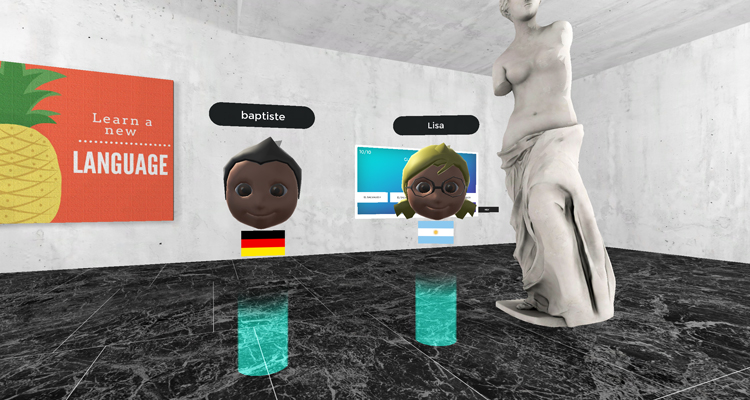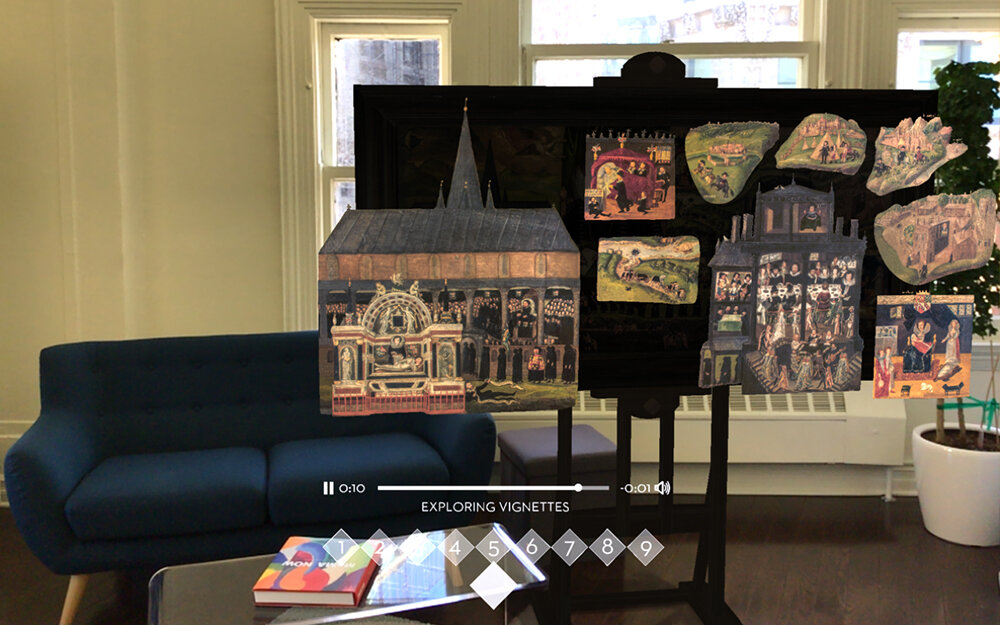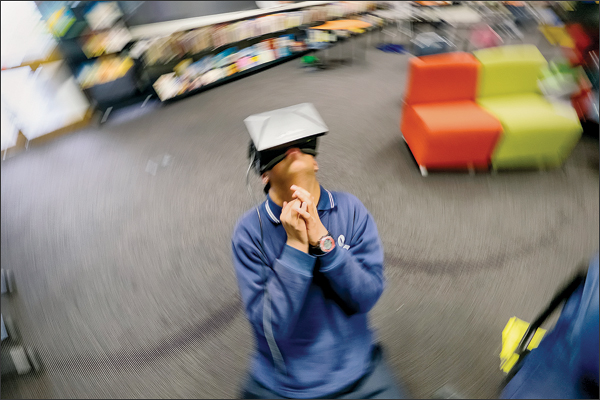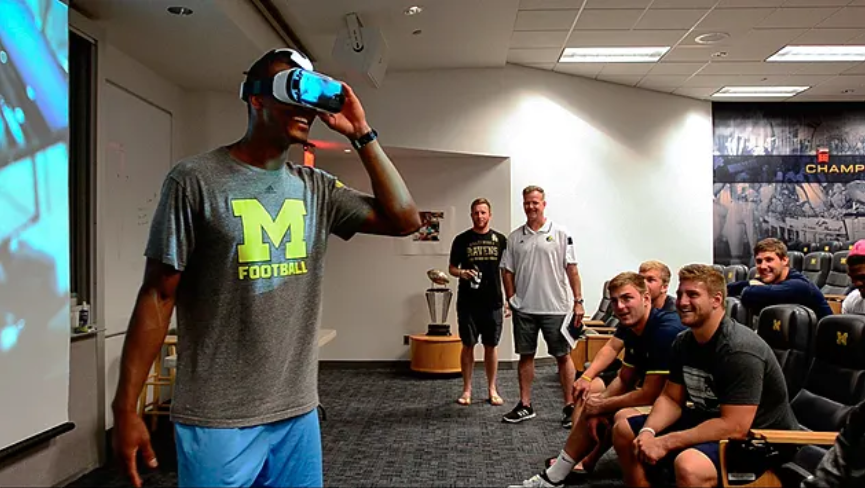The use of VR in education can make learning more entertaining, encourage STEM programs, and help with distance education.
Moreover, immersive technology can improve students’ learning experience while teaching them to embrace technology.
From virtual field trips on the planet Mars to roleplaying as histories greatest public figures, here are eight fascinating examples of immersive technology in modern education:

1. Learning Languages (Unimersiv)
With the Unimersiv app and Oculus Rift headset, students can meet people from any country in the world and learn languages in VR.
The Unimersiv app is free to download on the Oculus Store, making it easily accessible to a wide range of students. The company named this interactive experience the “Language Room.”
Unimersiv offers more than just an opportunity to learn a foreign language. Users can also work on their social skills and learn about different cultures directly from native speakers.
Having the opportunity to speak to native speakers will help students develop better pronunciation and, in the process, lose the fear of speaking in a second language. Unimersiv lets students practice their language skills in a real-world setting, making it one of the more effective methods of virtual language learning.

2. Museum Tours (Boulevard)
Students can be vividly immersed in arts and culture with VR museum tours created by Boulevard.
Rather than learning about art from textbooks, students can observe world-famous masterpieces and learn about those works of art. In addition, these experiences are led by famous artists, curators, and authors who know how to retain the listeners’ attention.
Boulevard’s VR experience helps teachers to increase students’ engagement. With the use of VR, students can visit some of the best museums in the world directly from the classroom.
3. Human Chemistry (InMind2)
Understanding human chemistry can be a complicated task for some students. InMind2’s scientific VR game can change that.
With InMind2, students will be able to learn how human chemistry works in a fun and safe environment. In this educational VR experience, students investigate a teenager named John. That is, they investigate the influence of human chemistry on shaping John’s self. They also control his growth from a teenager to an adult.
Students get different life paths to choose from, and they have to control their emotions according to specific situations.
Amanda Sully, a VR developer and contributor writer at BestEssaysEducation and TrustMyPaper, shared her thoughts on InMind2’s VR solution: “What InMind2 achieves is that it directly involves students in human chemistry. Instead of reading about it, they can experience the influence of human chemistry on people’s lives,” says Amanda.
4. Learning History (History Maker VR)
Memorizing history lessons is a whole lot easier when you’re part of history.
HistoryMaker VR allows students to step into the shoes of a famous figure from US history and perform a set of impactful historic monologues from a customizable set.
Jesse Schell, CEO of Schell Games, explained the mission behind HistoryMaker VR: “We wanted to create something that not only allows students to learn but, more importantly, experience the words on the page. So often, reading about people and events from the past feels hollow because it’s difficult to relate,” she said. “With HistoryMaker VR, we hope to fill that void and make history learning interactive and engaging,” added Jesse.
Some of the famous figures in whom students can turn themselves into are:
- Abigail Adams
- Abraham Lincoln
- Benjamin Franklin
- George Washington Carver
- Harriet Tubman
- Mark Twain (a.k.a. Samuel Clemens)

5. Special Education
The Jackson School in Victoria, Australia, has found a way to make learning easier and more interactive for children with special needs. They have used the Oculus Rift headset to help them visualize certain lessons in order to gain a better understanding of what they are learning.
Special needs students can do their therapeutic exercises in VR, allowing for a more hands-on learning experience. According to technology and special education instructor Mathieu Marunczyn, some of the lessons, such as exploring planets and stars, even have a calming effect on students.
Mr. Marunczyn explained why he is on board with using VR in special education: “Everything takes on a massive scale. It just provokes and promotes a very imaginative response from students, and ultimately that’s what I want to see.”
6. Field Trip to Mars (Lockheed Martin)
This field trip is definitely something that students will remember. The goal is to inspire students’ interest in outer space.
Lockheed Martin has gone all out to enable children to take realistic field trips to Mars. The company eliminated the need for VR headsets by fixing transparent 4K displays and switchable glass film to the windows of an actual school bus. These interactive displays offered high-res visuals of the planet Mars.
To ensure that children were completely immersed in the experience, Lockheed Martin mapped the streets of Washington DC and actually drove students along a set route throughout the city; no matter where the bus drove, students felt as though they were exploring the surface of Mars.
7. Laboratories (Labster)
Labster enables a safe environment for learning STEM subjects, offering more than 100 types of virtual labs.
Teachers in particular could benefit heavily from this innovation. With students free to work on their experiments safely from a virtual environment, educators can instead focus their attention on presenting the material the best they can.
The VR laboratories can be used for all sorts of subjects, such as chemistry, biology, and physics. Students can use VR to study the principles of atomic structures, animal genetics, fermentation, and much more.

8. Campus Visits
VR can also enable students to assess colleges they are interested in. Some schools have already begun offering their own VR campus tours. With images and videos that showcase campuses in immersive 360-degrees, students can explore prospective schools with ease regardless of their real-world location.
For example, the University of Michigan Football program has created a VR tour that allows students to experience what it would be like to play at their university’s stadium. This is a perfect practice to win over talented football players.
VR – The Future of Education
As you can tell, VR technology can apply to a wide range of education. This technological innovation can assist students, teachers, and schools in achieving a higher level of education. VR may not be in every classroom by tomorrow, but it is something to look forward to in regard to the future of education.
Feature Image Credit: Lockheed Martin
The post 8 Inventive Examples Of Immersive Technology In Education appeared first on VRScout.
from VRScout https://ift.tt/3ifuni8
via IFTTT
No comments:
Post a Comment